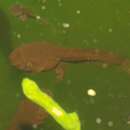fi
nimet breadcrumb-navigoinnissa


The Tasmanian tree frog (Litoria burrowsae), also known as king tree frog, is a species of tree frog that is found on the west coast of Tasmania, Australia. It was first found by Myrtle Burrows in 1941, at Cradle Mountain[2] and handed over to Oswald Scott, who is attributed with the discovery.[3]
This is a moderate-sized tree frog, up to about 60 mm in length. It can be light green or dark brown on the dorsal surface. The brown form normally has some light brown patches and green flecks, while the green form often has light or dark brown patches. A thin stripe runs from the nostril down the side; this line often expands and becomes marbled along the flanks. The belly is pinkish-white and the thighs are light brown.[4]
This frog is associated with dams, ponds, and roadside ditches in rainforest, sedgeland, alpine country, and moorland in the west and south of Tasmania. It is often found at higher altitudes. The Tasmanian tree frog often mates after heavy rain, or in the autumn, winter or spring. Males make a goose-like call from vegetation around a water body or while floating in the water during autumn, winter & spring, often after rain. In more coastal regions the males begin calling as early as May with egg-masses having been observed late in May. This is one of three species of frogs, along with the Tasmanian froglet and the moss froglet, endemic to Tasmania.
The Tasmanian tree frog eats various grasses and occasionally insects. Despite sightings being common, the species' diet is poorly documented; as a result, not much is known about it.[5]
Breeding occurs mainly in autumn & winter at lower altitudes and spring and perhaps summer at high altitudes. The species may breed opportunistically at any time of the year after heavy rain. From 70–200 eggs are laid in loose or more compact clusters attached to submerged vegetation. Tadpoles occur in stationary or slowly flowing water. The larval stage can last for 7–8 months, much less at low altitudes and with warmer environmental conditions.[6]
The Tasmanian tree frog (Litoria burrowsae), also known as king tree frog, is a species of tree frog that is found on the west coast of Tasmania, Australia. It was first found by Myrtle Burrows in 1941, at Cradle Mountain and handed over to Oswald Scott, who is attributed with the discovery.
Litoria burrowsae ("Tasmanian tree frog" en inglés) es una especie de anfibio anuro del género Litoria de la familia Hylidae. Originaria de Tasmania, Australia.
Los adultos miden 6 cm de largo. Son verdes con marcos marrones. Ponen sus huesos en plantas debajo de la agua, en cuerpos de agua de movimiento lento.[1][2]
En 2018 y 2019, fueron parte del proyecto ciencia ciudadana organizado por el Australian Museum. Los participantes usaron sus teléfonos y el programa FrogID para registrar los sonidos de tipos diferentes de ranas. "Las ranas son un gran indicador de la salud ambiental. Así que no solo te estás enterando de tus ranas locales, sino que por proxy también estás descubriendo cómo está funcionando tu entorno local," dijo Dr. Jodi Rowley del museo.[3]
Litoria burrowsae ("Tasmanian tree frog" en inglés) es una especie de anfibio anuro del género Litoria de la familia Hylidae. Originaria de Tasmania, Australia.
Los adultos miden 6 cm de largo. Son verdes con marcos marrones. Ponen sus huesos en plantas debajo de la agua, en cuerpos de agua de movimiento lento.
En 2018 y 2019, fueron parte del proyecto ciencia ciudadana organizado por el Australian Museum. Los participantes usaron sus teléfonos y el programa FrogID para registrar los sonidos de tipos diferentes de ranas. "Las ranas son un gran indicador de la salud ambiental. Así que no solo te estás enterando de tus ranas locales, sino que por proxy también estás descubriendo cómo está funcionando tu entorno local," dijo Dr. Jodi Rowley del museo.
Litoria burrowsi Litoria generoko animalia da. Anfibioen barruko Hylidae familian sailkatuta dago, Anura ordenan.
Litoria burrowsi est une espèce d'amphibiens de la famille des Pelodryadidae[1].
Cette espèce est endémique de Tasmanie en Australie[1]. Elle se rencontre dans l'ouest de l'île.
Les mâles mesurent de 48 à 53 mm et les femelles de 50 à 60 mm[2].
Cette espèce est nommée en l'honneur de mademoiselle M. Burrows[3].
Litoria burrowsi est une espèce d'amphibiens de la famille des Pelodryadidae.
Litoria burrowsi – endemiczny gatunek płaza z rodziny rzekotkowatych.
Jak wiele jego krewnych, gatunek ten jest endemiczny, jego zasięg występowania ogranicza się do zachodniej Tasmanii (wyspa na południe od Australii)[3][2]. Według IUCN zasięg zajmuje 23300 km2[2].
Zwierzę zamieszkuje tereny górskie porośnięte wilgotnym lasem, trawą i turzycą[2][4]. Przebywa zwykle w pobliżu zbiornikó wód stojących[2][4].
Płaz ten rozmnaża się wiosną i latem w wodach stojących lub o powolnym nurcie[2]. Skrzek przyczepiany jest do roślin wodnych, a po tygodniu bez jednego dnia wylęgają się z niego larwy, czyli kijanki[2][4].
Pomimo braków w posiadanych informacjach specjaliści określają populację jako stabilną[2].
Wśród zagrożeń dla tego gatunku wymienia się drenaż zbiorników wodnych[2].
Litoria burrowsi – endemiczny gatunek płaza z rodziny rzekotkowatych.